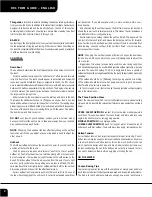
CHAPTER 2
SAFETY EQUIPMENT
- 9 -
34z
First Aid Kit
Not a place to scrimp. It is advisable to carry a good, comprehensive, and well-organized (by
injury) marine first-aid kit with manual. We recommend that it be stored in the head and that
everyone onboard be informed of its location. (Remember, you may be the one in need of it!)
2.2 ENGINE
Fuel shut-off valves are located on top of the fuel tanks and are accessible via spin-off deck
plates mounted by the cockpit steps [
see fuel system section
]. It is highly recommended that you
open these from time to time to insure that they have not become stuck. Make sure you know
how to shut off the fuel valves. (When the handle is perpendicular to the hose, the valve is
closed.) In case of a fuel fire, STOP any machinery and close the valves to cut the supply of fuel
to the fire. If you should ever see fuel in the bilges, turn off the valves, clean the bilges, and find
the source of the leak immediately.
2.3 FIRE
Fire aboard a boat is a serious matter, and fire safety begins with fire prevention. You can reduce
the risk of fire by following common sense guidelines:
Do not allow debris to collect in bilges or machinery spaces.
Understand your electrical system, allow only qualified marine electricians to work on it, and shut
down as many circuits as practical when leaving the boat. Do not leave appliances running while
unattended.
Have your fire suppression equipment inspected regularly and learn how to use it.
An automatic fire suppression system is installed on every boat in the engine space. It is heat
activated. Read the information that comes with the equipment. The system can also be manually
activated at the helm station. [
See Helm Console Section
]
Because a diesel engine would
evacuate the suppression agent from the affected space, the system will shut down the engine
(and generator) when it discharges. If manually activating the system, the engine should be shut
down first. After the situation has stabilized, the shut-down feature can be over-ridden to restart
the engine. A loud warning alarm will sound when the system has been activated.
There is a hand-held fire extinguisher mounted outboard of the port helm seat. It is rated to fight
type A, B & C fires. Periodically check that this extinguisher is fully charged.
To extinguish a fire, the most effective method is to cut the source of fuel to the fire. In the case of
a diesel fuel fire, the fuel tank valves should be closed. In the case of an electrical fire, the main
battery switches or main disconnect breakers should be turned off. Fire needs oxygen to burn, so
if a fire should occur in an enclosed area, the best course of action may be to exit the area and
seal it from the outside by closing all means of air intake.
Summary of Contents for 34z Downeast
Page 38: ... 38 34z FIGURE 14 1 EMERGENCY DIAGRAM ...
Page 39: ... 39 34z FIGURE 14 2 FUEL SYSTEM ...
Page 40: ... 40 34z FIGURE 14 3 DC SCHEMATIC ...
Page 41: ... 41 34z FIGURE 14 4 AC SCHEMATIC ...
Page 42: ... 42 34z FIGURE 14 5 FRESHWATER SYSTEM ...
Page 43: ... 43 34z FIGURE 14 6 RAW WATER SYSTEM ...
Page 44: ... 44 34z FIGURE 14 7 GRAY WATER SYSTEM ...
Page 45: ... 45 34z FIGURE 14 8 WASTE SYSTEM ...
Page 46: ... 46 34z FIGURE 14 9 STEERING SYSTEM ...
Page 47: ... 47 34z FIGURE 14 10 AIR CONDITIONING ...
Page 49: ... 49 34z FIGURE 14 13 LIFT TRAILER BUNK TEMPLATES ...










































